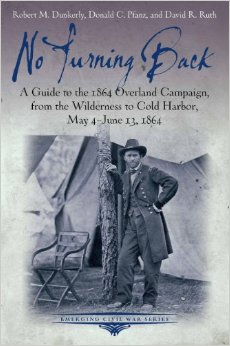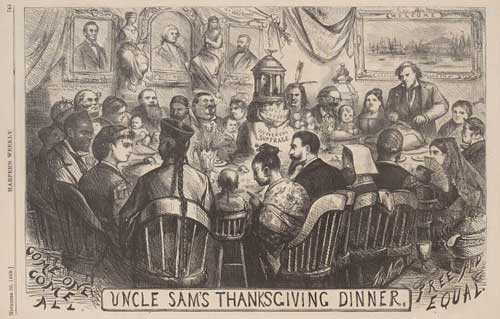No Turning Back – A Guide to the Overland Campaign, from May 4-June 13, 1864 by Robert M. Dunkerly, Donald C. Pfanz, and David R. Ruth. Savas Beatie, 2014. Paper, ISBN: 161121193X. $12.95.
 For many years, historians and Civil War enthusiasts alike virtually ignored the grisly Overland Campaign of 1864. Its principal battlefields – namely the Wilderness, Spotsylvania Court House, North Anna, and Cold Harbor – were rarely visited. Over the years, the National Park Service, hand in hand with local and national preservation organizations, worked diligently to acquire land, maintain the grounds, and deflect constant pressure from well-financed developers threatening these battlefields. Still, in most cases, the public paid little attention.
For many years, historians and Civil War enthusiasts alike virtually ignored the grisly Overland Campaign of 1864. Its principal battlefields – namely the Wilderness, Spotsylvania Court House, North Anna, and Cold Harbor – were rarely visited. Over the years, the National Park Service, hand in hand with local and national preservation organizations, worked diligently to acquire land, maintain the grounds, and deflect constant pressure from well-financed developers threatening these battlefields. Still, in most cases, the public paid little attention.
But the historical fate of the Overland Campaign began to change about twenty-five years ago. Since then, a number of fine historians – including Noah Andre Trudeau, Gordon Rhea, Ernest Furgurson, and others – have presented works covering the campaign and its various battles. Most of these books focus on the strategic and tactical decisions of the opposing commanders. No Turning Back – A Guide to the Overland Campaign, from May 4-June 13, 1864 offers a different perspective on this campaign and is thus a welcome new addition to the literature.
The essence of this book, the latest in Savas Beatie’s Emerging Civil War Series, is true to its title: it is a combined motor vehicle and walking guide for visiting all of the primary battlefields and sites of the Overland Campaign. The first section, titled “Touring the Battlefields,” features six maps – the first of which provides an overview of the geographic limits of the campaign and the relative locations of the subsequent five maps. The following five maps illustrate each of the principal battles (Spotsylvania has two), and provide a corresponding list of numbered stops. The main body of the book then tracks the events of the campaign in a chronological manner using these numbered stops. The directions for reaching each stop are provided, along with GPS coordinates. They appear easy to follow and note potential traffic difficulties, provide instructions for vehicle parking, and address limitations regarding privately owned land. The hiking trails within the battlefields are also well defined.
An individual narrative is presented for each stop. They are, on the whole, well written and provide the background information vital for understanding the significance of each location and its place in the campaign. The authors infuse their narratives with interesting, humorous, and tragic anecdotes. This work also contains numerous photographs of the battles. It should also be mentioned that many of the numbered stops consist of storied mansions, taverns, churches, bridges and other man-made features outside the limits of the battles themselves. In some cases, these sites figured prominently in the movement of the armies during the campaign.
There are a few shortcomings. A person interested in acquiring a detailed study of the battles will have to find that information elsewhere. This volume was not intended to be a detailed tactical or operational study. Additionally, the scope of this work omits Sheridan’s Richmond and Trevilian Raids – including the battles of Yellow Tavern and Trevilian Station. There are also a few minor errors in the text. For example, there is some discussion of the role of the Pennsylvania Reserves during an action at Bethesda Church on May 30, 1864. This was the Reserves’ last battle before being mustered out of service and, in all honesty, they performed poorly. This part of the discussion is accurately conveyed, but the authors erroneously state that the men belonged to the Union II Corps. They were part of the V Corps.
Most historians recognize that the Overland Campaign was the first step on the long and bloody road to Appomattox. They also realize that the campaign was a complex affair, involving over 260,000 men and costing about 88,000 total battle casualties. In view of the campaign’s sheer magnitude and historical significance, a guide for touring its various battlefields is long overdue. I ardently recommend this book to anyone who wants to follow in the footsteps of the Army of the Potomac and Army of Northern Virginia.
Alfred C. Young III is an independent scholar and author of Lee’s Army During the Overland Campaign: A Numerical Study (2013).
